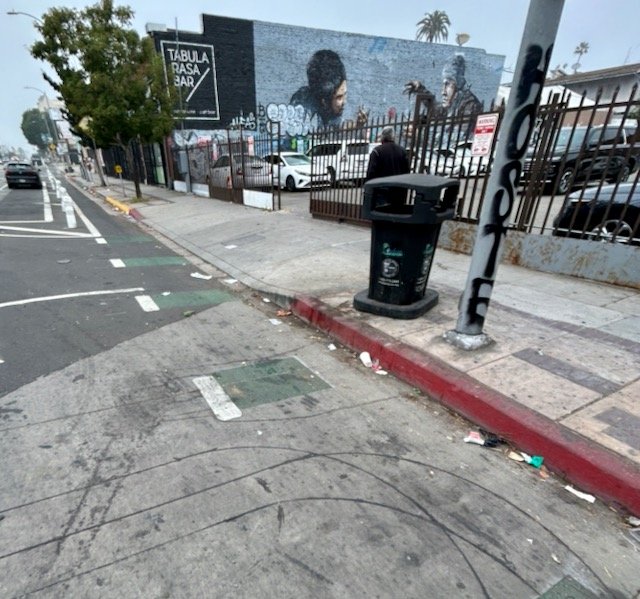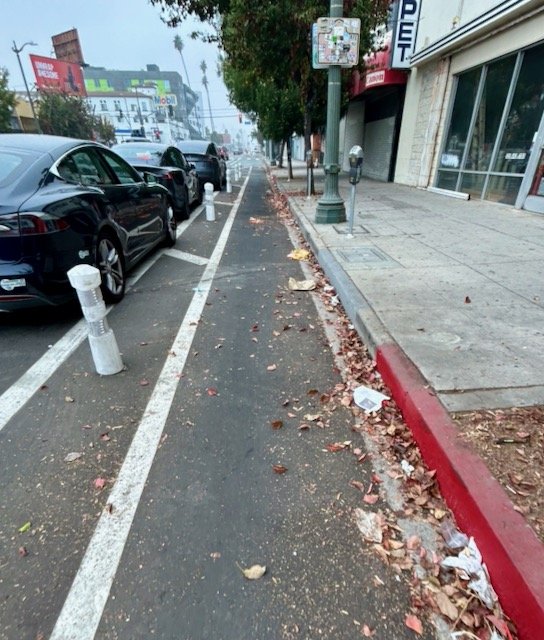Adding Protected Bike Lanes Is a Huge Win — Now For Keeping Them Clean
Last summer, at CicLAvia: Meet the Hollywoods, the new 2.1 mile stretch of protected bike lanes on Hollywood Boulevard got their close-up.
But once the cameras departed and the streets reopened to car traffic, the dirty work of keeping the Hollywood Boulevard bike lanes truly began.
The City of Los Angeles added 22.5 lane-miles of new or improved bike facilities in Fiscal Year 2023-2024, according to Joe Linton’s annual analysis at Streetsblog L.A, the lowest number in five years. With such a paltry number of bike lane miles added this year, you’d hope it would be at least manageable to keep LA’s protected bike lanes clean.
But, across the city, many of Angelenos’ favored protected bike paths serve as dustbins for the street’s detritus —
whether it’s Venice Boulevard…
Or Reseda Boulevard…
Or the Orange Line Bike Lane…
Or the aforementioned Hollywood Boulevard…
… Los Angeles’s bike lanes need more regular maintenance and cleaning.
The City Council Weighs In
With that in mind, on Aug. 10, councilmembers Hugo Soto-Martinez and Bob Blumenfeld submitted a motion to the city council, which passed unanimously, that directed the Bureau of Street Services (BSS) to investigate the resources needed to clean LA’s protected bike lanes more frequently.
Typical street-sweeping equipment doesn’t work on protected bike lanes because they are so narrow: cities must use specialized street sweepers—of which BSS currently owns and operates just two—which they use to sweep existing protected bike lanes on a quarterly basis.
“It’s unacceptable that limited city staffing and resources allow trash and debris to pile up in protected bike lanes,” said Councilmember Soto-Martinez. “We need to get back to basics — maintaining what we build and ensuring it’s safe and enjoyable to use every day. That’s why we’re focusing on practical, nuts-and-bolts solutions while working to secure the resources needed for consistent sweeping.”
The Soto-Martinez/Blumenfeld motion instructs BSS, with support from the LADOT and the City Administrative Officer, to report on:
Resources needed (equipment and staffing) per mile to sweep existing protected bicycle lanes every other week.
An overview of existing practices for protected bicycle lane maintenance, including equipment inventory, equipment transportation needs, staffing needs, cost per mile of maintaining protected bicycle lanes using existing practices, and current protected bike lane maintenance funding mechanisms.
Best practices review for protected bicycle lane maintenance, including frequency, cost-benefits analysis of alternative equipment/methods, and additional factors that should be considered identified in this review.
(CD13 has reached out to the departments and expects a report to be ready in early 2025, so the councilors will have it in hand before budget conversations for the next Fiscal Year begin in April.)
As Soto-Martinez and Blumenfeld write in their motion, the status quo for keeping protected bike lanes clean is “not sustainable, viable, or equitable.”
“Regular maintenance is needed to keep new infrastructure accessible,” they write, “and new protected bike lanes should receive sweeping as often as any other part of the street.”
“As regular cyclists know all too well, just because a bike lane is called protected or separated doesn’t mean it’s safe to ride on,” said SAFE Executive Director and Founder Damian Kevitt. “The city has invested tens of millions in safer cycling infrastructure but hasn’t spent the hundreds of thousands needed to maintain it. That’s what SAFE is working on changing.”
Getting Our Hands Dirty to Keep Our Streets Clean
As we await the Bureau of Street Service’s report on protected bike lanes, SAFE — like many concerned organizations and cyclists — has been taking matters into our own hands: each month, SAFE volunteers gather for Clean Ride Crew, an opportunity to both:
clean and maintain Class I and Class IV bike lanes and
leverage our efforts to advocate for improved safety and cleanliness on LA’s bike lanes.
Clean Ride Crew gathers every month, fluorescent vests and garbage bags in tow, to make bike lanes safer and cleaner for cyclists; in 2024, Clean Ride Crew improved bike lanes on Reseda Boulevard, Riverside Drive, Hollywood Boulevard, Jefferson Boulevard, and more.
“Clean Ride Crew gives cyclists a great chance to see what’s involved in cleaning our bike lanes and a better understanding of how rough some of the routes are in LA,” said Kesper Wang, SAFE’s new bicycle outreach advocate. “Getting their hands dirty helps volunteers better advocate for solutions across the city.”
Since we began Clean Ride Crew in August 2023, SAFE volunteers have donated nearly 400 hours of their time to collect more than three tons of trash across 18 miles of bike lanes. That’s a fantastic accomplishment, but it's still just a drop in the bucket. We need a coordinated, sustainable solution to keep our protected bike lanes clean.
The BSS report on protected bike lanes is still a couple of months out; outside of volunteer events like Clean Ride Crew, what can LA cyclists do to keep protected bike lanes rideable?
Council District 13 urges Angelenos to submit clean-up requests via myLA311 and adds that they are “working on more proactive solutions.”
Proactive solutions are just what we need to keep our protected bike lanes clean and safe, and we at SAFE are looking forward to the release of the report next year — and working with volunteers, agencies, elected officials, and all stakeholders across the area to keep our streets safe and accessible for everyone.
Interested in joining us for Clean Ride Crew or other SAFE events? Sign up to volunteer here!








